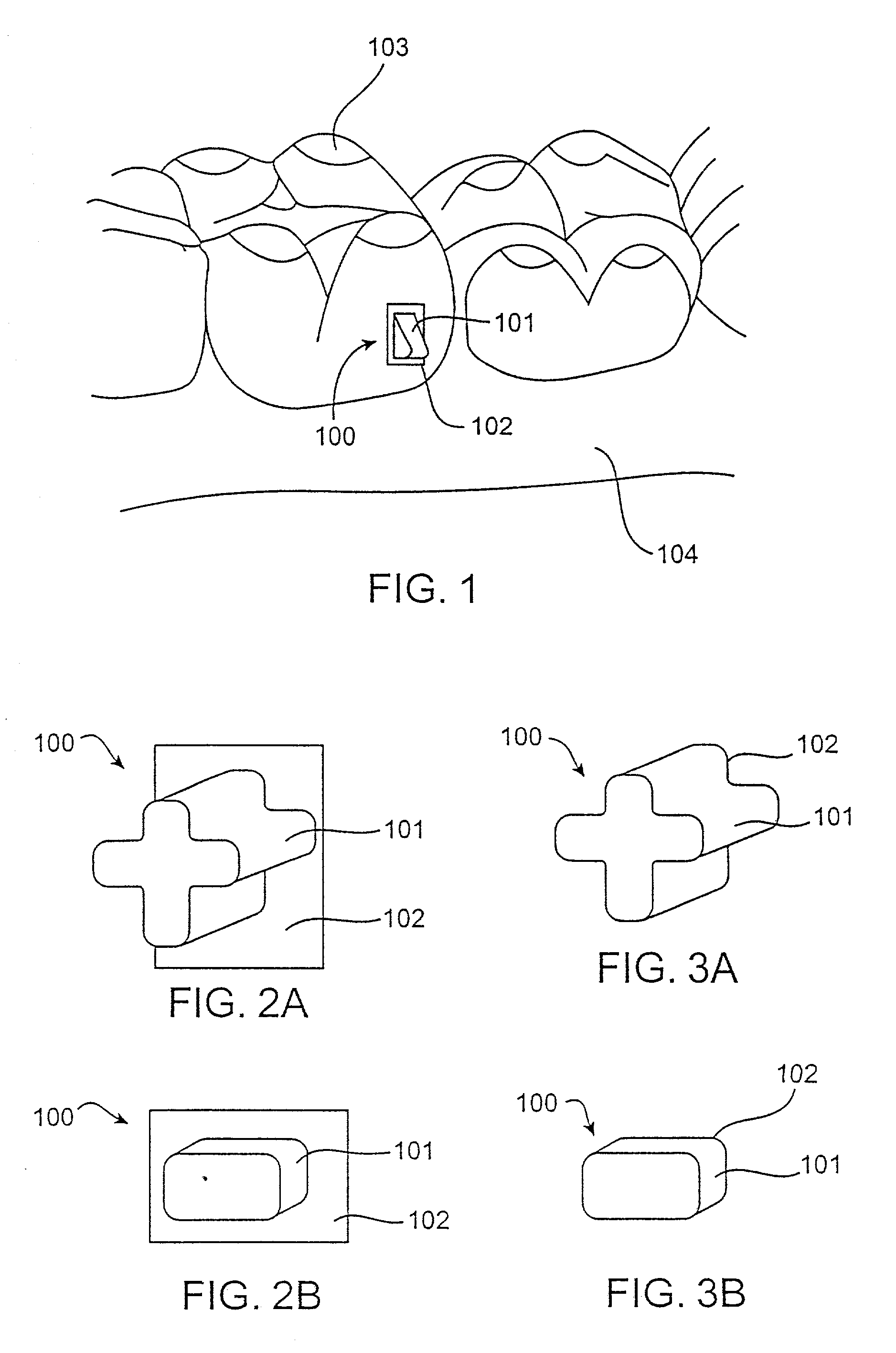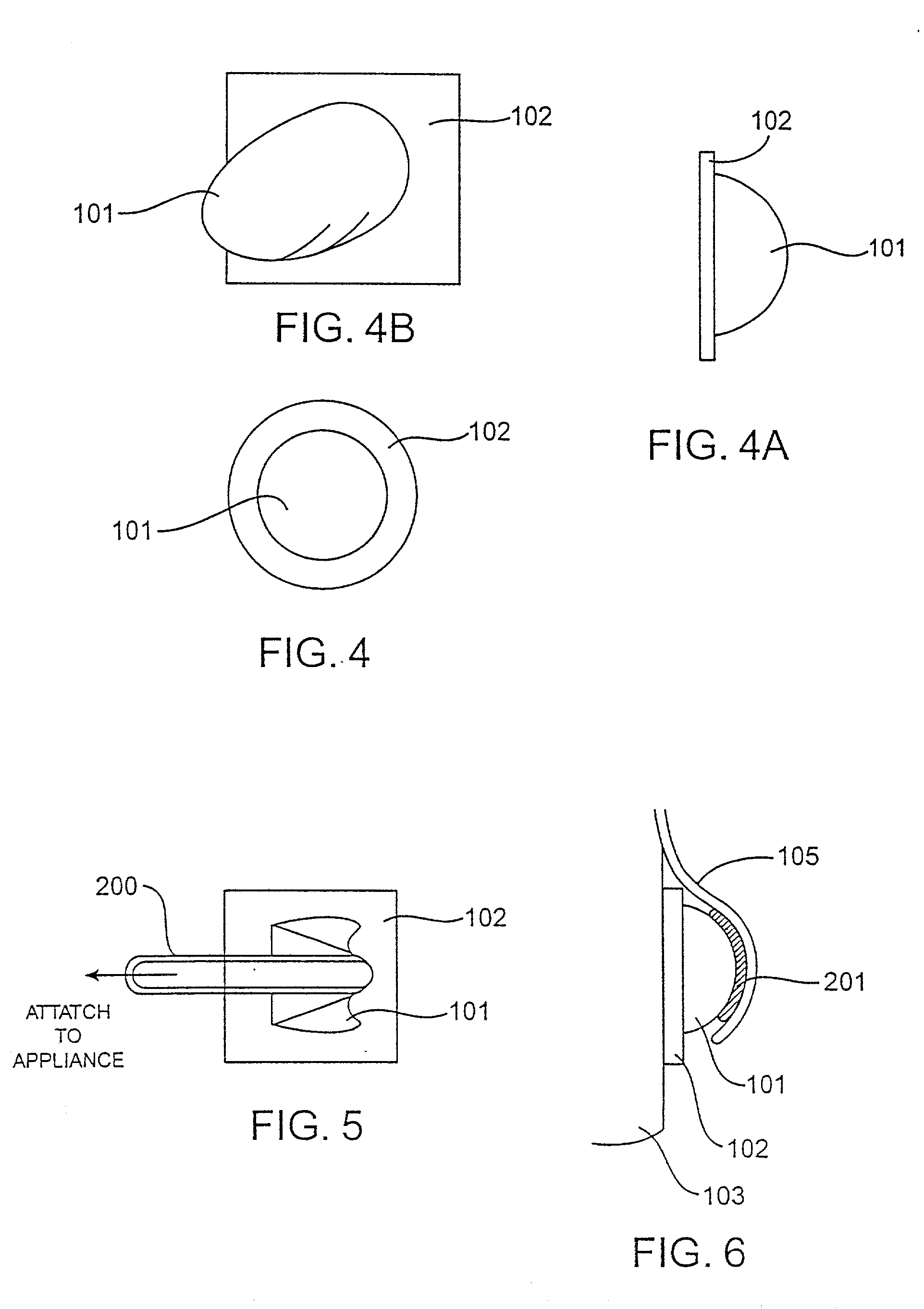[0009] The present invention provides improved devices, systems and methods for removably attaching a dental positioning appliance to the dental features of a patient during orthodontic treatment. Such removable dental positioning appliances usually comprise an elastic polymeric shell having a cavity for receiving at least some of a patient's teeth and are often preferred over conventional braces for tooth repositioning due to comfort, appearance and ease of use. These appliances function by applying force to specific surfaces of the teeth or dental features to cause directed movement. However, the type of movement and level of force applied is usually dependent on the surface characteristics and positions of the dental features. In many cases, the native
tooth surface(s) and other dental features of a patient are inadequate to provide sufficient anchoring or to impart sufficient force on the teeth to be repositioned. To overcome these limitations, the present invention uses one or more attachment devices which may be attached to preselected attachment points on the teeth or dental features to provide the appropriate physical leverage. Specific design and location of these attachment devices may provide newly achievable and / or more effective repositioning forces, anchoring ability and appliance retention. The systems and methods of the present invention provide the design, production and use of such attachment devices with removable dental positioning appliances in orthodontic treatment.
[0010] The use of attachment devices in combination with removable dental positioning appliances provides the patient with the benefits of removable appliances while retaining the ability to extrude, rotate, and otherwise manipulate teeth as with conventional braces. Like conventional braces, attachment devices may be bonded to the surface of the teeth in order to provide physical features which facilitate the application of controlled force. The attachment devices of the present invention may have a very simple construction, in some instances being only a bump, bead, wedge, or other body or structure which can be fixedly attached to the surface of a tooth or other dental feature in order to transmit force generated by the dental positioning appliance to the dental feature and / or to anchor the positioning appliance to teeth in order to permit the appliance to apply forces elsewhere in the patient's teeth. In such instances, the attachment device acts simply as a
handle or lever to assist in the transmission of force between the teeth and the dental positioning appliance. In other instances, the attachment device may feature a hook, similar in design to those used for mounting elastic bands. The hook may be engaged with a number of ligatures, bands, filaments, coils or other connecting members to effect repositioning of the teeth, usually in combination with the dental positioning appliance. The hook may serve as an anchor in the repositioning of other teeth, or it may serve as a point of purchase to apply directed force to the surface of the tooth to which it is bonded.
[0017] Similarly, a malleable material may be molded into a desired form and polymerized by
exposure to an environmental condition or stimulus. Such
polymerization may permanently hold the material in the desired form. This may be useful in both constructing the attachment device and bonding the device to a dental surface. For example, malleable material may be inserted in a mold of an attachment device.
Polymerization, as described above, may result in a rigid attachment device in the molded form. In a preferred embodiment, the mold of the attachment device may be an impression in the wall of an elastic positioning appliance. This may ensure proper
surface geometry for association between the attachment device and the appliance. Likewise,
polymerization of the material while the appliance is in place over the dental features may simultaneously bond the attachment device to the dental feature. This may ensure proper alignment of the attachment device and the receiving impression in the appliance, and it may also preclude the need for additional bonding materials.
[0021] In a fifth aspect of the present invention, an additional method is provided to produce and / or bond an attachment device to a dental feature. Two preferred embodiments are applicable for use with any
dental appliances. The first embodiment involves a multi-tooth template which may be used to produce and / or bond an attachment device to a dental feature. The multi-tooth template may be thin and flexible to fit over multiple dental features at once, allowing multiple attachment devices to be placed at the same time. Receptacles may be present in the template to receive a polymerizing material. When the template is inserted and seated in position in the
oral cavity, the polymerizing material will be in contact with the dental surface and will be in the proper position. The material may be polymerized by any means, typically by an external stimulus or environmental condition.
Polymerization may simultaneously harden the material and bond the material to the dental surface. Upon removal of the template, the formed attachment device may remain in place on the dental surface. This method may be similar or identical to
casting with polymerizing material and computer-aided
casting with polymerizing material, however it may differ in that the template may not be used as the repositioning appliance. This difference may afford the use of template designs that are not applicable to repositioning appliances. For example, the template may be comprised of a material that is unsuitable for a repositioning appliance, or it may contain additional design features, such as handles, that would interfere with such usage. Similarly, the template may be fabricated from a mold of the patient's present tooth configuration, rather than the tooth configuration prescribed by an elastic positioning appliance. This may facilitate the method of attachment device production and / or bonding due to the closer fit of the template to the tooth configuration.
[0023] Single-tooth and multi-tooth templates may allow the production and placement of one or more attachment devices to a dental feature independent of the geometry of certain adjacent dental features. Thus, a template may be used throughout various stages of orthodontic repositioning treatment. This may be useful to replace an attachment device which has broken off mid-treatment or to place new attachment devices throughout treatment. As described above, at least one receptacle may be present in the template to receive a polymerizing material. When the template is inserted and seated in position in the
oral cavity, the polymerizing material will be in contact with the dental surface and will be in the proper position. The material may be polymerized by any means, typically by an external stimulus or environmental condition.
Polymerization may simultaneously harden the material and bond the material to the dental surface. Upon removal of the template, the formed attachment device may remain in place on the dental surface. Alternatively, templates may be used to bond any attachment device to a dental feature surface. For example, a pre-fabricated attachment device may be bonded to a surface with the use of a template. An attachment device may be inserted in a receptacle of a template,
adhesive applied to the base of the attachment device and the template applied to the dental surface. After bonding has occurred, the template may be removed. Thus, the template may provide proper positioning and orientation. Likewise, a template may be used to form an attachment device using a polymerizing material, and then used again to bond the attachment device to a dental surface.
[0024] In a sixth aspect of the present invention, a method is provided to improve the production of templates or elastic positioning appliances. In a preferred embodiment, additional structures are provided in the mold of the dental feature with desired attachment device. The structures may be of any geometry and are typically placed near the gingival surface. When a template or appliance is thermoformed over the mold and additional structures, the structures provide a protrusion which aids in drawing the template or appliance from the mold. The protrusion may then be removed before use.
 Login to View More
Login to View More  Login to View More
Login to View More 


